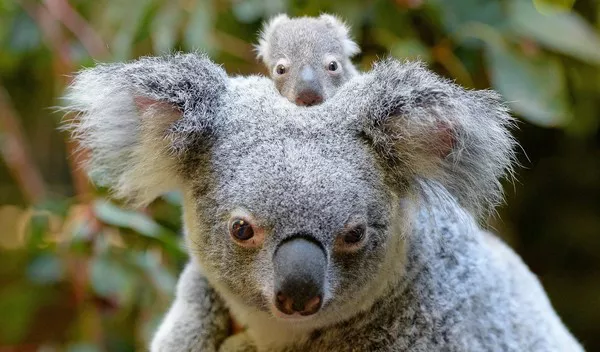In the intricate tapestry of the animal kingdom, sleep serves as a vital physiological process essential for survival and well-being. While the duration and patterns of sleep vary widely across species, some animals stand out for their remarkable ability to clock in extensive hours of slumber. In this exploration, we delve into the fascinating world of the top 10 animals that are undisputed champions in the realm of sleep, unraveling the science behind their prolonged periods of rest and the data that sheds light on their impressive sleep habits.
Top 10 Animals That Sleep the Most
1. Koala (Phascolarctos cinereus)
Sleep Strategy:
The Koala, native to Australia, takes the crown as one of the longest-sleeping mammals, spending an average of 18 to 22 hours per day in slumber. This marsupial’s affinity for eucalyptus leaves, its primary diet, plays a significant role in its extended sleep duration. The leaves are not only a source of nutrition but also have a sedative effect, contributing to the Koala’s lethargic lifestyle.
Data Insights:
Studies conducted by the Australian Sleep Association and wildlife researchers have monitored the sleep patterns of Koalas in captivity and in the wild. These observations consistently highlight the Koala’s propensity for extended periods of sleep, showcasing the impact of diet on sleep behavior.
2. Brown Bat (Myotis lucifugus)
Sleep Strategy:
Bats, known for their nocturnal lifestyle, are among the animals with unique sleep patterns. The Brown Bat, in particular, can sleep for an impressive 19.9 hours per day. This extended sleep duration is influenced by the bat’s high metabolism and the energy expenditure associated with flight.
Data Insights:
Research published in the journal “Sleep” and conducted by bat biologists involves monitoring the sleep patterns of Brown Bats in captivity. The findings shed light on the correlation between the bat’s energy demands, flight activities, and their need for prolonged periods of rest.
3. Armadillo (Dasypodidae)
Sleep Strategy:
Armadillos, with their distinctive armor-like shells, are known for their peculiar sleep habits. These creatures can sleep up to 18 hours a day, interspersed with short periods of activity. The Armadillo’s sleep duration is attributed to its low metabolic rate and the need to conserve energy.
Data Insights:
Studies conducted by zoologists and wildlife researchers, including research published in the “Journal of Mammalogy,” have provided insights into the sleep patterns of Armadillos. The data emphasizes the link between the Armadillo’s energy-saving mechanisms and its extended sleep duration.
4. Python (Pythonidae)
Sleep Strategy:
Pythons, the non-venomous constrictor snakes, exhibit an intriguing sleep pattern characterized by long periods of rest. These reptiles can sleep for about 18 hours a day, and their sleep duration is influenced by the digestive process after consuming large prey.
Data Insights:
Observational studies by herpetologists and snake experts have offered insights into the sleep behavior of Pythons. The correlation between feeding patterns, digestion, and prolonged periods of rest is supported by data gathered in controlled environments and natural habitats.
5. Sloth (Bradypodidae)
Sleep Strategy:
Sloths, renowned for their slow and deliberate movements, are equally famous for their extended periods of sleep. These arboreal creatures can sleep for an impressive 15 to 20 hours per day, conserving energy in line with their low-calorie diet and slow metabolism.
Data Insights:
Studies conducted by primatologists and sloth researchers have delved into the sleep habits of these tree-dwelling mammals. The data underscores the importance of energy conservation and metabolic adaptations in shaping the sleep patterns of Sloths.
6. Opossum (Didelphidae)
Sleep Strategy:
Opossums, marsupials known for their pouches, are adept at catching up on their beauty sleep. With a sleep duration ranging from 18 to 20 hours per day, these nocturnal creatures rely on extended periods of rest to recover from their nightly foraging activities.
Data Insights:
Research by wildlife biologists and studies published in journals such as “Mammalian Biology” provide data on the sleep patterns of Opossums. The findings emphasize the correlation between nocturnal behavior, energy expenditure, and the need for prolonged sleep.
7. Lion (Panthera leo)
Sleep Strategy:
Lions, the majestic big cats, are known for their impressive catnaps. In the wild, lions can sleep for up to 20 hours a day, conserving energy for their bursts of intense activity during hunting. This sleep pattern is influenced by the predator’s role in the food chain.
Data Insights:
Field studies by wildlife conservationists and be havioral ecologists have provided insights into the sleep habits of lions. Tracking the sleep-wake cycles of wild lion prides offers valuable data on the adaptation of sleep patterns to predatory lifestyles.
8. Walrus (Odobenus rosmarus)
Sleep Strategy:
Walruses, marine mammals known for their tusks and blubbery bodies, have a unique sleep pattern. These aquatic dozers can sleep for around 19 hours a day, with brief intervals of activity. Their extended sleep duration is linked to the energy demands of swimming and foraging.
Data Insights:
Research conducted by marine biologists and observations in controlled environments, such as aquariums, contribute to the understanding of Walrus sleep patterns. The data highlights the adaptation of sleep habits to the semi-aquatic lifestyle of these marine mammals.
9. Giant Armadillo (Priodontes maximus)
Sleep Strategy:
The Giant Armadillo, a rare and elusive species, boasts a sleep pattern aligned with its burrow-dwelling lifestyle. With a sleep duration of approximately 18 hours a day, these armored mammals prioritize rest to cope with the challenges of their underground habitats.
Data Insights:
Due to the elusive nature of the Giant Armadillo, field studies by zoologists and conservationists, along with data from captive populations, contribute to our understanding of their sleep behavior. The findings underscore the role of burrowed habitats in shaping sleep patterns.
10. Human (Homo sapiens)
Sleep Strategy:
While not breaking records like some animals on this list, humans are included for perspective. The average adult human typically requires 7 to 9 hours of sleep per night for optimal health and well-being. Despite having a comparatively shorter sleep duration, the complexity of human sleep cycles and the importance of quality sleep make it a crucial aspect of daily life.
Data Insights:
Extensive research in the field of sleep medicine, psychology, and neuroscience provides data on human sleep patterns. Sleep studies, polysomnography, and wearable technology contribute to our understanding of the factors influencing the sleep duration and quality in humans.
See Also: Top 20 Fastest Animals On Land
Conclusion:
In the realm of the animal kingdom, sleep manifests in a myriad of forms, each intricately tied to the unique characteristics and lifestyles of different species. From the koala’s eucalyptus-induced dreams to the lion’s regal catnaps, the top 10 animals that sleep the most showcase the remarkable diversity of sleep strategies evolved in response to ecological niches and survival needs. The data-driven insights from research and observations offer a glimpse into the fascinating world of animal sleep, where slumber becomes a critical component of the intricate dance of life.
You Might Be Interested In:
























